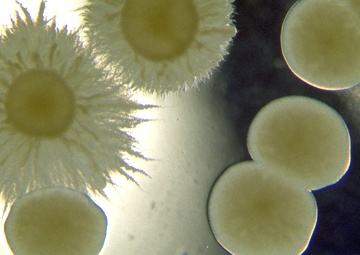
Virulent colonies of a yeast, Candida albicans, respond to a chemical in nutrient medium by sprouting invasive filaments. Mutant derivatives, with damage to one gene, fail to respond.
One of the most common fungal causes of disease in humans, Candida albicans, is rendered nonvirulent by a mutation in a single gene-the only known difference between the two strains shown here. Presumably the mutant gene is required in the pathogenic response.
Laboratory of Gerald Fink, Whitehead Institute. Photograph by Felice Frankel, MIT.
Here, a visually compelling image was produced by violating a tenet of good laboratory practice: the two fungal strains were grown in the same dish specifically for the resulting picture. Omission of the dish's edge inhibits perception of scale but produces a more striking picture. Tradeoffs like this figure prominently in workshop discussions.

